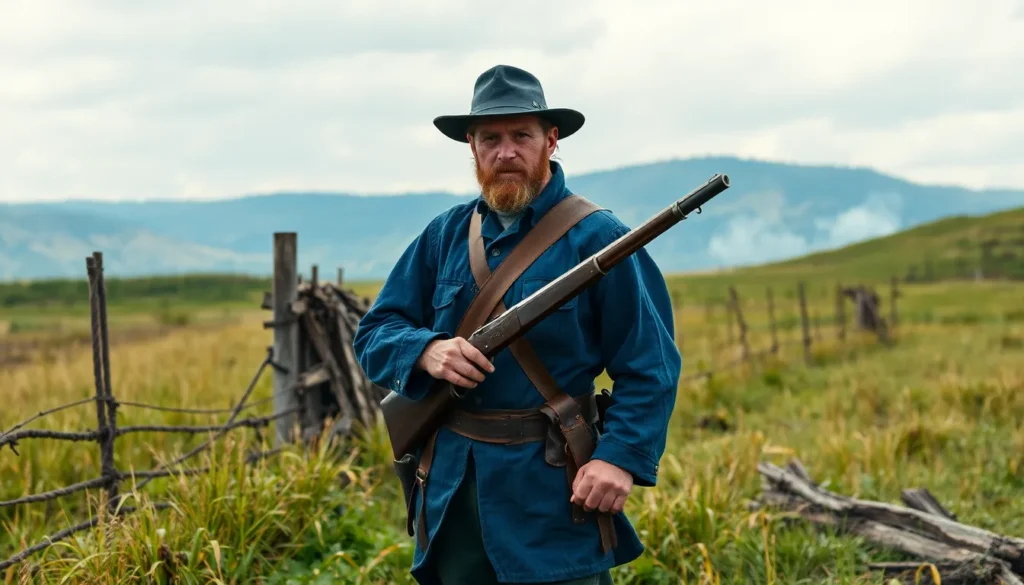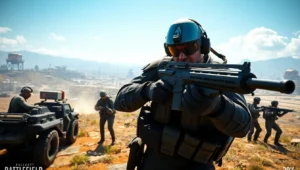Warfare has always been a captivating spectacle, a dramatic dance of strategy, courage, and sometimes sheer chaos. From the epic clashes of ancient warriors to the strategic maneuvers of modern armies, each battlefield tells a story that’s as rich as it is complex. Imagine the clanging of swords, the thundering of hooves, and the smell of gunpowder wafting through the air—it’s like a historical theme park, minus the cotton candy.
Table of Contents
ToggleOverview of Battlefield Historical Warfare
Battlefield historical warfare encompasses a broad spectrum of conflicts across various eras, showcasing the evolution of military tactics and technologies. Ancient battles, such as those fought in Greece and Rome, relied heavily on formations and direct confrontations, leading to decisive outcomes that shaped the course of civilizations. Notable conflicts like the Battle of Thermopylae demonstrate the courage of warriors facing overwhelming odds.
Medieval warfare introduced the use of castles and long-range weapons, transforming battle strategies. The introduction of archers and mounted knights created new dynamics on the battlefield. Significant events, like the Hundred Years’ War, exemplify the shift in tactics, blending siege warfare with open-field engagements.
The Renaissance period signaled further advancements as gunpowder and artillery made their debut. Battles became more chaotic and lethal, evidenced by the conflicts during the Thirty Years’ War. Their intensity and scale highlighted the increasing complexity of warfare strategies, reflecting changes in political power and territorial disputes.
Into the 19th century, industrialization altered the nature of warfare with the emergence of rifles and railways. Such innovations increased troop mobility and firepower, as seen in the American Civil War. The shift from traditional formations to trench warfare in World War I marked a dramatic evolution, with technology dictating military outcomes.
Each of these historical eras reveals distinct patterns in the conduct of warfare, showcasing humanity’s relentless pursuit of victory. Analyzing battlefield tactics offers insights into the social, political, and technological factors influencing conflicts throughout time. Emphasizing these elements unfolds a narrative that explains how historical battles shaped contemporary worldviews and military doctrine.
Key Battles and Their Impact

Key battles throughout history showcase pivotal moments that shaped nations and military strategies. Each conflict reveals insights into the dynamics of warfare.
The Battle of Gettysburg
The Battle of Gettysburg occurred from July 1 to July 3, 1863, during the American Civil War. Union and Confederate forces faced off in Pennsylvania, marking a turning point. Over 51,000 soldiers became casualties, highlighting the battle’s intense violence. Union victory halted Robert E. Lee’s invasion of the North, bolstering Northern morale. The battle also influenced public support, leading to greater commitment to the war effort. Gettysburg Cemetery served as a site for Lincoln’s famous address, reinforcing the principles of liberty and equality.
The Battle of Waterloo
The Battle of Waterloo took place on June 18, 1815, ending Napoleon Bonaparte’s rule. Allied forces, led by the Duke of Wellington and Gebhard Leberecht von Blücher, confronted Napoleon’s army in Belgium. Strategic positioning and timely coordination proved crucial to the Allies’ success. Napoleon’s defeat marked the end of the Napoleonic Wars, reshaping Europe’s political landscape. The Congress of Vienna soon followed, resulting in a balance of power that maintained peace for several decades. This battle remains a significant reference point in military strategy and European history.
Strategies and Tactics
Strategies and tactics define the conduct of warfare, shaping the outcome of battles and conflicts throughout history.
Offensive vs. Defensive Strategies
Offensive strategies prioritize attack to seize territory or weaken the enemy. These approaches often involve surprise, such as ambushes or flanking maneuvers. Defensive strategies, in contrast, focus on protecting assets, utilizing terrain and fortifications to resist enemy advances. Historical examples illustrate this dichotomy. General Robert E. Lee employed offensive tactics during the Battle of Gettysburg, while the Union forces utilized defensive positions effectively. Each strategy carries inherent risks, impacting troop morale and resource allocation. Understanding these strategies reveals how commanders adapt their approaches based on context and goals.
Notable Tactics Through History
Notable tactics throughout history showcase the evolution of warfare. The phalanx formation used by the Greeks emphasized unity and strength in numbers. Meanwhile, the use of cavalry during the Middle Ages, particularly in battles such as those fought by the Mongols, allowed for rapid breakthroughs. Artillery’s rise during the Renaissance shifted battlefield dynamics, providing long-range capabilities that changed engagement styles. In World War I, tactics evolved further with trench warfare, forming static positions that defined the brutal Western Front. Each tactical development influenced subsequent military doctrines, highlighting the ongoing cycle of adaptation in battlefield strategies.
The Evolution of Warfare Technology
Warfare technology has changed dramatically over centuries. Innovations in weapons and armor played crucial roles in shaping battle strategies.
Weapons and Armor Developments
Advancements in weaponry marked pivotal transitions in warfare. The introduction of bronze weapons around 3000 BCE allowed for more effective combat. Iron swords and spears followed, providing greater durability and lethality in battles. Crossbows and longbows emerged during the medieval period, enhancing range and precision. With the Renaissance, gunpowder revolutionized warfare, leading to cannons and musketry that changed battlefield dynamics forever. Armor also evolved, shifting from chainmail to plate armor, providing soldiers with improved protection but sacrificing mobility. Each development fundamentally transformed how battles unfolded and strategies were devised.
The Role of Communication
Effective communication became essential in warfare as conflicts grew in scale. Order relays using runners provided immediate, though limited, coordination during ancient battles. The advent of flags and signals allowed leaders to convey tactical movements more efficiently, even amidst chaos. During the 19th century, the telegraph introduced a revolutionary method for long-distance communication on the battlefield. Commanders could relay orders swiftly and coordinate troop movements with greater accuracy. Today, digital communication systems provide near-instantaneous updates, forever altering command structures and battlefield strategies. Each advancement in communication technology significantly enhanced military effectiveness and response times.
Cultural and Social Implications
Warfare significantly impacts cultural and social structures. Battles shape national identities, fostering a sense of unity. Community narratives often revolve around heroic deeds on the battlefield, influencing literature and art for generations.
Historical conflicts yield social change, with shifts in gender roles emerging during wartime. Women frequently took on responsibilities traditionally held by men, altering societal norms. The roles seen during World War II, for instance, led to long-term changes in perceptions of women’s capabilities and rights.
Military campaigns also affect economic conditions. War demands resources, prompting advancements in technology and industry. The industrialization of the 19th century facilitated the mass production of weapons, changing economic landscapes and labor demands.
Cultural rituals often originate from battle. Memorials and commemorative events honor those who fought, embedding the past into contemporary society. Traditional practices, such as remembrance ceremonies, serve to connect communities with their historical narratives.
Social hierarchies frequently evolve post-conflict. Military leaders can rise to political power, as seen in various revolutions and coups. Changes in leadership dynamics frequently occur as citizens seek stability and direction after turmoil.
Relationships between nations shift due to warfare. Alliances form and dissolve based on shared experiences in conflict, affecting diplomatic relations. Outcomes from battles, like those at Waterloo and Gettysburg, reshape regional politics, proving how warfare extends beyond the battlefield.
Warfare’s implications reach deep into cultural memory, shaping values and influencing future generations. The interplay between conflict and society continues to define nations and their identities.
Battlefield historical warfare remains a profound reflection of human nature and society. The intricate tapestry of strategies and technologies reveals how conflicts have shaped nations and identities. Each battle tells a story of courage and innovation that resonates through time.
As warfare evolves, so does the understanding of its complexities. The lessons learned from past conflicts continue to inform modern military strategies and societal values. By studying these historical battles, one gains insight into the enduring impact of warfare on culture and the human experience. The legacy of these battlefields serves as a reminder of the sacrifices made and the changes that follow in the wake of conflict.





